USAID Famine Seed Project meeting held in Nepal
 On 30 June 2010, a USAID Famine Seed Project meeting was organized at CIMMYT’s South Asia Office in Kathmandu, Nepal. Seventeen participants, including those from the Nepal Agriculture Research Council (NARC), CIMMYT-Nepal, CIMMYT-Bangladesh, and Cereal Systems Initiative for South Asia (CSISA) HUB partners in Nepal, attended the meeting. The objectives of the day were to: (1) review 2009-10 crop cycle work and progress, (2) to develop a work plan for the upcoming 2010-11 cycle and, (3) to strengthen collaboration with technology-delivering stakeholders.
On 30 June 2010, a USAID Famine Seed Project meeting was organized at CIMMYT’s South Asia Office in Kathmandu, Nepal. Seventeen participants, including those from the Nepal Agriculture Research Council (NARC), CIMMYT-Nepal, CIMMYT-Bangladesh, and Cereal Systems Initiative for South Asia (CSISA) HUB partners in Nepal, attended the meeting. The objectives of the day were to: (1) review 2009-10 crop cycle work and progress, (2) to develop a work plan for the upcoming 2010-11 cycle and, (3) to strengthen collaboration with technology-delivering stakeholders.
Arun Joshi, CIMMYT wheat breeder, opened the event with an overview of the progress and on-going challenges facing the six countries involved in the USAID project (Afghanistan, Bangladesh, Egypt, Ethiopia, Pakistan, and Nepal). He identified the project’s major activities as: (1) identification of suitable Ug99 resistant varieties and their pre- and post-release seed production, and (2) delivery of seed to farmers and rapid dissemination. CIMMYT, ICARDA, the BGRI, and national wheat programs are jointly implementing these activities.
This year, 2010, marks 25 years of strong partnership between CIMMYT and NARC, a milestone highlighted by NARC Executive Director B. Mishra, who also pointed out that the Famine Fund meeting was the first major NARC-CIMMYT meeting this year. Mishra said that Nepal is doing its best to produce sufficient amounts of Ug99 resistant seed, with a goal of producing enough to replant at least 5% of Nepal’s wheat area within the next two to three years. He happily announced that the new Ug99 resistant variety BL 3063 (GS348/NL746//NL748) has been approved by NARC’s technical committee, and will soon be released for cultivation.
Next, NARC scientists J. Tripathi, S.R. Upadhyay, and N.R. Gautam presented the specifics of Nepal’s work and efforts from the 2009-10 crop cycle, and outlined a potential 2010-11 work plan. They said that the estimated seed production of resistant lines in 2010–11 will be sufficient to meet 7.3% of the effective seed market, and to cover 2.4% of the total wheat area in Nepal. M.R. Bhatta and Sarala Sharma highlighted the importance of farmer participatory research for successful dissemination of new resistant seed varieties in Nepal.
The following presentation included explanations and deatils about the progress of the field demonstrations overseen by Nepal’s CSISA HUB. D.P Sherchan, CSISA HUB manager, and A.P. Regmi, agronomist, said that field demonstrations are important for the delivery of Ug99 resistant seed and seed resistant to other rusts, and that in large-scale trials, the yield of newly obtained resistant varieties (BL 3063 and Francolin) under zero tillage was significantly superior to the local checks.
Toward the end of the meeting, K.D. Joshi, South Asia regional coordinator for CAZS Natural Resources, part of Bangor University, UK, explained ways to enhance linkages with NGOs and newly emerging private sector companies to promote seed production and dissemination. T.P. Tiwari, CIMMYT-Bangladesh cropping system agronomist, summarized his experiences with particular agronomic interventions that could benefit field trials in Nepal.
The discussion outcomes led to the development of similar agronomic plans for Nepal and Bangladesh to harness the potential of Ug99 resistant lines. The meeting also provided a good update on progress in the USAID seed project, and provided ideas on how to strengthen ties between CSISA, NGOs, and the private sector, as well as providing suggestions on new agronomic innervations that could be integrated into trials in the upcoming crop cycle.
 The Chinese Academy of Engineering honored Zhonghu He, principal scientist of CIMMYT’s Global Wheat Program and China country representative, for his work with wheat quality improvement and promotion of China-CIMMYT collaboration. Zhonghu received the Guanghua Award in a ceremony on 09 June 2010 in Beijing. Established in 1996, this award recognizes Chinese scientists who have made signification contributions in applied science and management. To date, only eight scientists with agriculture or forestry backgrounds have received the Guanghua Award.
The Chinese Academy of Engineering honored Zhonghu He, principal scientist of CIMMYT’s Global Wheat Program and China country representative, for his work with wheat quality improvement and promotion of China-CIMMYT collaboration. Zhonghu received the Guanghua Award in a ceremony on 09 June 2010 in Beijing. Established in 1996, this award recognizes Chinese scientists who have made signification contributions in applied science and management. To date, only eight scientists with agriculture or forestry backgrounds have received the Guanghua Award.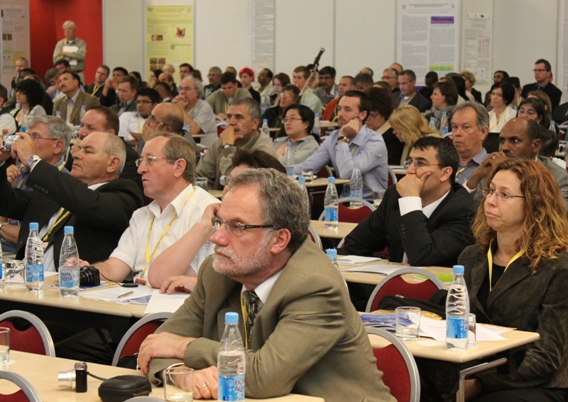 More than 600 wheat breeders, pathologists and representatives of national agricultural research institutions arrived in St. Petersburg to discuss rusts affecting wheat production globally. After introductory remarks byJeanie Borlaug Laube (BGRI chair), Ronnie Coffman (BGRI vice-chair), and Dr. Swapan Datta, DDG (CS) of ICAR, day started with session on ‘World of Rust: Global perspectives’:
More than 600 wheat breeders, pathologists and representatives of national agricultural research institutions arrived in St. Petersburg to discuss rusts affecting wheat production globally. After introductory remarks byJeanie Borlaug Laube (BGRI chair), Ronnie Coffman (BGRI vice-chair), and Dr. Swapan Datta, DDG (CS) of ICAR, day started with session on ‘World of Rust: Global perspectives’: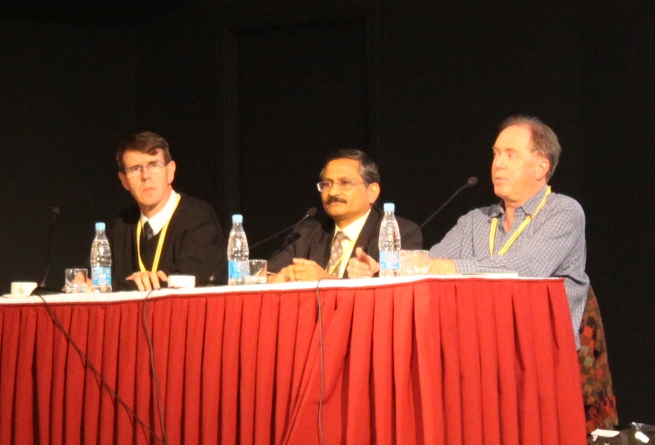
 Over 60 researchers, field technicians, farmers, machinery manufacturers, service providers, and extension workers attended two recent conservation agriculture (CA) training events in Bangladesh. The first event was held at the Bangladesh Agriculture Research Institute (BARI) station in Comilla on 28-29 April, followed by an event at the Wheat Research Centre of BARI in Dinajpur on 04-05 May. The events focused on machinery operation and maintenance, as well as the agronomy of dry direct-seeded rice (DSR). Both were part of joint CIMMYT-
Over 60 researchers, field technicians, farmers, machinery manufacturers, service providers, and extension workers attended two recent conservation agriculture (CA) training events in Bangladesh. The first event was held at the Bangladesh Agriculture Research Institute (BARI) station in Comilla on 28-29 April, followed by an event at the Wheat Research Centre of BARI in Dinajpur on 04-05 May. The events focused on machinery operation and maintenance, as well as the agronomy of dry direct-seeded rice (DSR). Both were part of joint CIMMYT-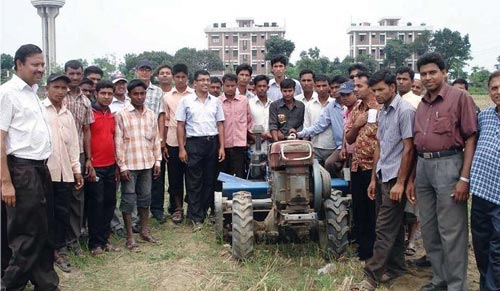 “Machinery operation and maintenance is vital for rapid dissemination of CA-based technologies,” said Jagadish Timsina, IRRI-CIMMYT senior cropping system agronomist. He added that this ACIAR-funded ricemaize project has been adapting and evaluating the PTOS and the bed former/planter at project sites, and has been refining these machines for their use in different soils with the help of agriculture engineers from the national agriculture research intuitions involved in the project. The project has given special emphasis to training and capacity building for machine use and has already trained more than 120 people from government and non-governmental organizations, as well as farmers, service providers, machinery manufacturers, and extension workers since it started in November 2008.
“Machinery operation and maintenance is vital for rapid dissemination of CA-based technologies,” said Jagadish Timsina, IRRI-CIMMYT senior cropping system agronomist. He added that this ACIAR-funded ricemaize project has been adapting and evaluating the PTOS and the bed former/planter at project sites, and has been refining these machines for their use in different soils with the help of agriculture engineers from the national agriculture research intuitions involved in the project. The project has given special emphasis to training and capacity building for machine use and has already trained more than 120 people from government and non-governmental organizations, as well as farmers, service providers, machinery manufacturers, and extension workers since it started in November 2008.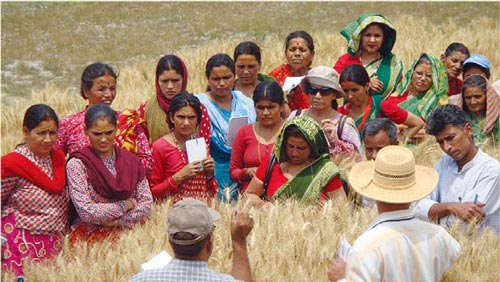
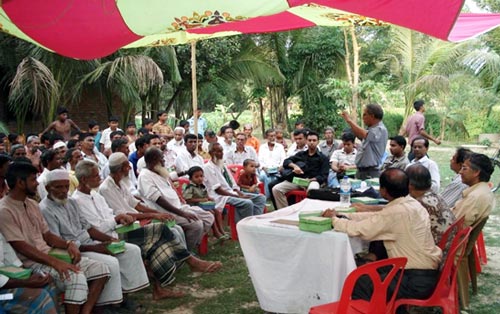 Various research and extensions workers collaborating with the project “Sustainable Intensification of Rice-Maize Systems in Bangladesh” organized five farmer field days throughout March and April 2010. The events took place in the districts of Comilla, Rangpur, and Rajshahi and attracted over 350 farmers.
Various research and extensions workers collaborating with the project “Sustainable Intensification of Rice-Maize Systems in Bangladesh” organized five farmer field days throughout March and April 2010. The events took place in the districts of Comilla, Rangpur, and Rajshahi and attracted over 350 farmers.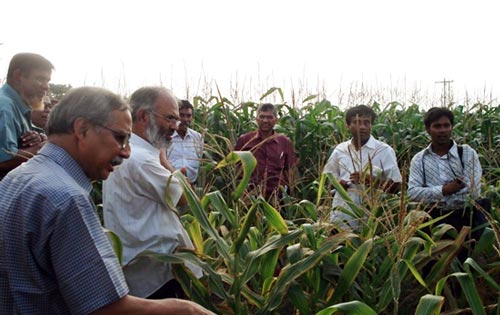 Though the project, which started in November 2008, initially focused on adaptive research in farmers’ fields, it is now starting to emphasize dissemination of improved CA practicies and SSNM technologies to farmers as well. This will be done through training and capacity building with researchers, farmers, extension workers, machinery manufacturers, and service providers.
Though the project, which started in November 2008, initially focused on adaptive research in farmers’ fields, it is now starting to emphasize dissemination of improved CA practicies and SSNM technologies to farmers as well. This will be done through training and capacity building with researchers, farmers, extension workers, machinery manufacturers, and service providers.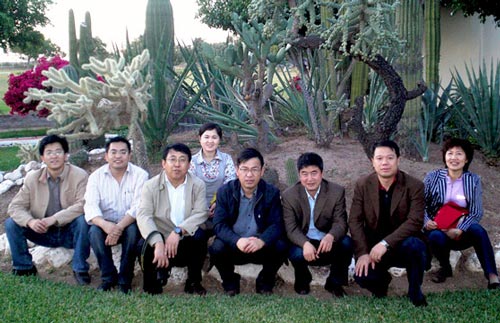 A delegation of eight scientists from the
A delegation of eight scientists from the 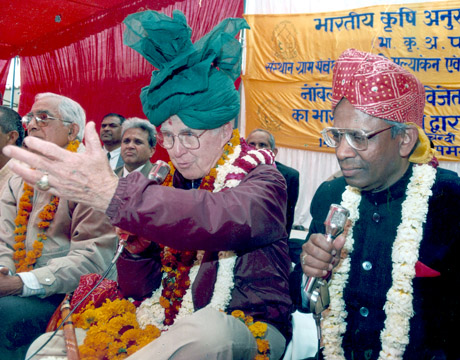 During 21-22 November, the
During 21-22 November, the 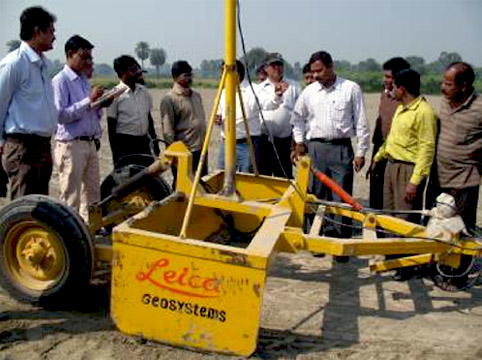 Nearly 20 delegates from North Bengal Agriculture University’s agricultural outreach stations and several local farmers attended a conservation agriculture (conservation agriculture) traveling training seminar in India during 29-30 October 2009.
Nearly 20 delegates from North Bengal Agriculture University’s agricultural outreach stations and several local farmers attended a conservation agriculture (conservation agriculture) traveling training seminar in India during 29-30 October 2009.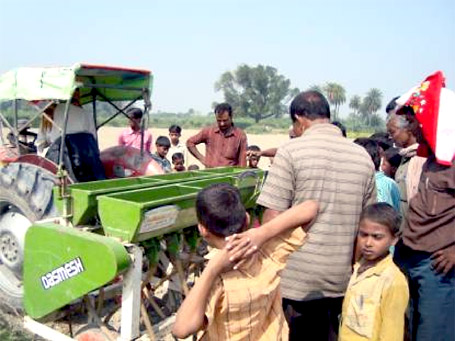 Participants then traveled to Rajendra Agriculture University’s (RAU), Pusa Farm, where they saw CA-based longterm experimental trials of rice-wheat and rice-maize systems. Following this, the delegation visited participatory trials of zero-till rice and listened to additional CA information and herbicide application techniques presented by CSISA hub manager Ravi Gopal. Finally, S. Chowdhury, CIMMYT seed production specialist, spoke about new wheat varieties suitable for the eastern Indo- Gangetic Plains.
Participants then traveled to Rajendra Agriculture University’s (RAU), Pusa Farm, where they saw CA-based longterm experimental trials of rice-wheat and rice-maize systems. Following this, the delegation visited participatory trials of zero-till rice and listened to additional CA information and herbicide application techniques presented by CSISA hub manager Ravi Gopal. Finally, S. Chowdhury, CIMMYT seed production specialist, spoke about new wheat varieties suitable for the eastern Indo- Gangetic Plains.